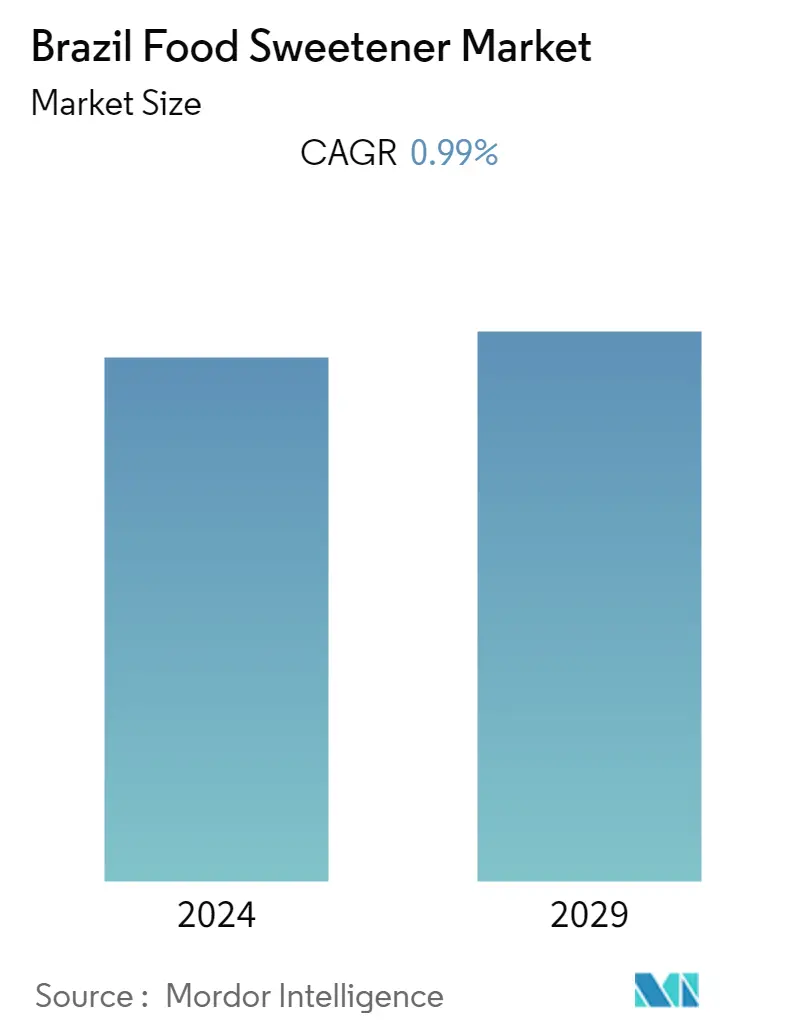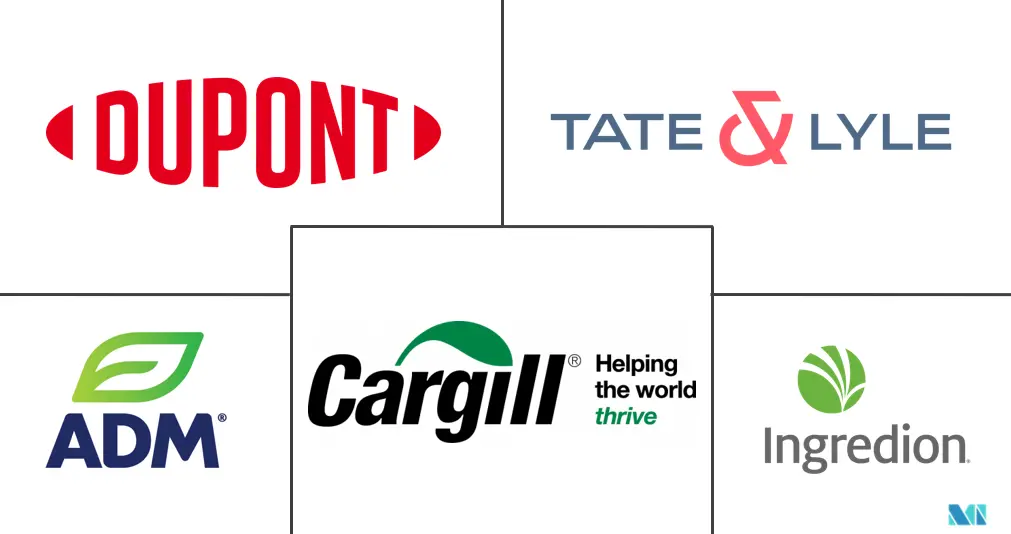Market Size of Brazil Food Sweetener Industry

| Study Period | 2019 - 2029 |
| Base Year For Estimation | 2023 |
| Forecast Data Period | 2024 - 2029 |
| Historical Data Period | 2019 - 2022 |
| CAGR | 0.99 % |
| Market Concentration | Low |
Major Players
*Disclaimer: Major Players sorted in no particular order |
Brazil Food Sweetener Market Analysis
Brazil's Food Sweetener Market is projected to grow at a CAGR of 0.99% over the forecast period.
Brazil is the world's largest producer and exporter of sugar. A high level of sweetener consumption, coupled with the emerging economic status of the country, makes it an attractive market destination. The changing consumer preference drives the demand for healthier and safer food products with high nutritional value. The increased consumption of sugar alternatives in the industry contributes to the increased demand for sweeteners such as tapioca among food and drink manufacturers. Tapioca syrup is nutrition-rich, gluten-free, and free of contaminants and genetically engineered components.
Brazil's stevia growth is due to increased awareness and usage of dietary foods. Another primary driver is the growing population of overweight, obese, and diabetic patients, causing growth in this category. The inclination toward low-calorie beverages, such as diet coke and low-calorie drinks, and low-calorie foods, such as yogurt, ice cream, and grain-based desserts, has gained popularity in Brazil. Also, with the changing regulatory environment and permission for using sweeteners in dairy products, biscuits, and confectionery, the artificial sweeteners segment is witnessing high growth.
Brazil Food Sweetener Industry Segmentation
Sweeteners are the various natural and artificial substances that impart a sweet taste to foods and beverages. Brazil's food sweetener market is segmented by type and application. Based on the type, the market is segmented into sucrose, starch sweeteners and sugar alcohols, and high-intensity sweeteners (HIS). Starch sweeteners and sugar alcohols are further sub-segmented into dextrose, high fructose corn syrup (HFCS), maltodextrin, sorbitol, and other starch sweeteners and sugar alcohols. The high-intensity sweeteners (HIS) are further sub-segmented into sucralose, aspartame, saccharin, neotame, stevia, cyclamate, acesulfame potassium (Ace-K), and other applications. Based on the application, the market is segmented into bakery and confectionery, dairy and desserts, meat and meat products, soups, sauces and dressings, and other applications. For each segment, market sizing and forecast have been done based on value (USD million).
| Product Type | ||||||||||
| Sucrose | ||||||||||
| ||||||||||
|
| Application | |
| Bakery and Confectionery | |
| Dairy and Desserts | |
| Beverages | |
| Meat and Meat Products | |
| Soups, Sauces, and Dressings | |
| Other Applications |
Brazil Food Sweetener Market Size Summary
Brazil's food sweetener market is experiencing growth driven by the country's status as a leading sugar producer and exporter, alongside a rising demand for healthier food options. The market is characterized by a shift in consumer preferences towards sweeteners that offer nutritional benefits, such as tapioca and stevia, which are gaining popularity due to their health-conscious attributes. The increasing prevalence of obesity and diabetes in Brazil has prompted a surge in demand for low-calorie and natural sweeteners, as consumers seek alternatives to traditional sugar. This trend is further supported by regulatory changes allowing the use of sweeteners in various food products, which has spurred innovation and expansion within the industry.
The market is fragmented with several key players, including Tate & Lyle, Cargill, and Archer Daniels Midland Company, who are focusing on developing and launching new products that cater to the growing demand for natural and organic sweeteners. The beverage industry, in particular, is a significant contributor to market growth, as manufacturers replace sugar with low or no-calorie substitutes in response to consumer preferences for diet beverages. Strategic initiatives such as mergers, acquisitions, and partnerships are prevalent among leading companies, aiming to enhance their market presence and meet the evolving needs of health-conscious consumers. The ongoing investment in research and development, as seen with companies like Amyris and Tate & Lyle, underscores the dynamic nature of Brazil's food sweetener market.
Brazil Food Sweetener Market Size - Table of Contents
-
1. MARKET DYNAMICS
-
1.1 Market Drivers
-
1.2 Market Restraints
-
1.3 Porter's Five Forces Analysis
-
1.3.1 Threat of New Entrants
-
1.3.2 Bargaining Power of Buyers/Consumers
-
1.3.3 Bargaining Power of Suppliers
-
1.3.4 Threat of Substitute Products
-
1.3.5 Intensity of Competitive Rivalry
-
-
-
2. MARKET SEGMENTATION
-
2.1 Product Type
-
2.1.1 Sucrose
-
2.1.2 Starch Sweeteners and Sugar Alcohols
-
2.1.2.1 Dextrose
-
2.1.2.2 High Fructose Corn Syrup
-
2.1.2.3 Maltodextrin
-
2.1.2.4 Sorbitol
-
2.1.2.5 Xylitol
-
2.1.2.6 Others
-
-
2.1.3 High Intensity Sweeteners
-
2.1.3.1 Sucralose
-
2.1.3.2 Aspartame
-
2.1.3.3 Saccharin
-
2.1.3.4 Cyclamate
-
2.1.3.5 Ace-K
-
2.1.3.6 Neotame
-
2.1.3.7 Stevia
-
2.1.3.8 Others
-
-
-
2.2 Application
-
2.2.1 Bakery and Confectionery
-
2.2.2 Dairy and Desserts
-
2.2.3 Beverages
-
2.2.4 Meat and Meat Products
-
2.2.5 Soups, Sauces, and Dressings
-
2.2.6 Other Applications
-
-
Brazil Food Sweetener Market Size FAQs
What is the current Brazil Food Sweetener Market size?
The Brazil Food Sweetener Market is projected to register a CAGR of 0.99% during the forecast period (2024-2029)
Who are the key players in Brazil Food Sweetener Market?
Tate & Lyle PLC, Cargill, Incorporated, Archer Daniels Midland Company, Ingredion Incorporated and DuPont de Nemours Inc. are the major companies operating in the Brazil Food Sweetener Market.

